|
PUERTO RICO -
Geography and Economy
http://en.wikipedia.org/wiki/Puerto_Rico
Climate
-
Located in the
tropics,
Puerto Rico has an average temperature of 82.4 °F
(28 °C) throughout the year, with an average minimum
temperature of 66.9 °F (19 °C) and maximum of 85.4 °F
(30 °C). Temperatures do not change drastically
throughout the seasons. The temperature in the south is
usually a few degrees higher than the north and
temperatures in the central interior mountains are
always cooler than the rest of the island. The
hurricane season
spans from June to November. The all-time low in Puerto
Rico has been 39 °F (4 °C), registered in
Aibonito.[85]
The average yearly precipitation is 1,687 mm (66 in).[86]
Geography -
The maximum length of the main island from east to west
is 180 km (110 mi), and the maximum width from north to
south is 65 km (40 mi).[76]
Puerto Rico is the smallest of the Greater Antilles. It
is 80% of the size of
Jamaica,[77]
just over 18% of the size of
Hispaniola
and 8% of the size of Cuba, the largest of the Greater
Antilles.[78]
The highest elevation in Puerto Rico,
Cerro de Punta
1,339 meters (4,393 ft),[75]
is located in this range. Another important peak is
El Yunque,
one of the highest in the Sierra de Luquillo at
the
El Yunque National
Forest, with an
elevation of 1,065 m (3,494 ft).[79]
Puerto Rico
lies at the boundary between the Caribbean and North
American
plates
and is being deformed by the
tectonic
stresses caused by their interaction. These stresses may
cause
earthquakes
and
tsunamis.
These
seismic
events, along with
landslides,
represent some of the most dangerous
geologic hazards
in the island and in the northeastern Caribbean.
Main
article:
1918 San Fermin earthquake
- The
earthquake triggered a
tsunami
with waves measured at approximately 20–35 ft; it swept
the west coast of the island. The resulting tsunami
affected primarily the west coast towns of the Island
(primarily Mayaguez).
The
Puerto Rico Trench,
the largest and deepest trench in the Atlantic, is
located about 115 km (71 mi) north of Puerto Rico at the
boundary between the Caribbean and North American
plates.[83]
It is 280 km (170 mi) long.[84]
At its deepest point, named the
Milwaukee Deep,
it is almost 8,400 m (27,600 ft) deep, or about 5.2
miles.[83]
Biodiversity -
Across the island
in the southwest, the 40 km2 (15 sq mi) of
dry land at the Guánica Commonwealth Forest Reserve[88]
contain over 600 uncommon species of plants and animals,
including 48 endangered species and 16 endemic to Puerto
Rico.
Economy -
The economy of
Puerto Rico is classified as a
high income economy
by the
World Bank
and as the most competitive economy in
Latin America
by the
World Economic Forum.[151][152]
Its economy is mainly driven by
manufacturing,
primarily
pharmaceuticals,
textiles,
petrochemicals,
and
electronics;
followed by the
service industry,
primarily
finance,
insurance,
real estate,
and
tourism.[l][m
Demographics -
From 2000 to 2010,
the population decreased, the first such decrease in
census history for Puerto Rico. It went from the
3,808,610 residents registered in the 2000 Census to
3,725,789 in the 2010 Census.[174
During the 19th century hundreds of
Corsican, French,
Lebanese,
Chinese,
and
Portuguese
families arrived in Puerto Rico, along with large
numbers of immigrants from Spain (mainly from
Catalonia,
Asturias,
Galicia,
the
Balearic Islands,
Andalusia,
and the
Canary Islands)
and numerous Spanish loyalists from Spain's former
colonies in South America. Other settlers included
Irish,
Scots,
Germans,
Italians
and thousands others who were granted land by Spain
during the Real Cedula de Gracias de 1815 ("Royal
Decree of Graces of 1815"),
which allowed European Catholics to settle in the island
with land allotments in the interior of the island,
provided they agreed to pay taxes and continue to
support the Catholic Church.
A recent genetic DNA study conducted in
Puerto Rico suggests that between 52.6% and 84% of the
population possess some degree of Amerindian
mtDNA
in their maternal ancestry, usually in a combination
with other ancestries. In addition, these DNA studies
show Amerindian ancestry in addition to the Taíno.[177][178][179]
Puerto Rico has recently become the
permanent home of over 100,000 legal residents who
immigrated from the
Dominican Republic
and other Latin American countries. These include Cuba,
Colombia,
and
Venezuela,
as well as surrounding
Caribbean islands,
Haiti,
Barbados,
and the U.S. Virgin Islands among them.
Languages -
Although English is one of the two official languages in
Puerto Rico, it is spoken by a small minority—less than
10%-- of the population. Spanish is the dominant
language of business, education and daily life on the
island, spoken by over 95% of the population.[185]
(…)
English is taught as a second language and is a
compulsory subject from elementary levels to high
school.
Religion -
Pollster Pablo Ramos reported in 1998 that the
population was 38% Catholic, 28% Pentecostals, 4%
Baptist, and 18% members of independent churches;
Protestants collectively numbered almost two million of
an island population of 3.6 million. "The conclusion is
that Puerto Rico is no longer predominantly Catholic." (The
San Juan Star, April 12, 1998: "Study reflects
growing numbers of churchgoers").
In 1952, a
handful of American Jews established the island's first
synagogue
in the former residence of William Korber, a wealthy
Puerto Rican of Jewish
German
descent. It was designed and built by the
Czech
architect
Antonin Nechodoma.[196][197]
The synagogue, called Sha'are Zedeck, hired its
first rabbi in 1954.[198]
Puerto Rico has the largest Jewish community in the
Caribbean, numbering 3,000, and is the only Caribbean
island in which the
Conservative,
Reform
and
Orthodox Jewish
movements all are represented.[198][199]
In 2007, there
were about 5,000 Muslims in Puerto Rico, representing
about 0.13% of the population.[200][201]
Eight
mosques
are located throughout the island, with most Muslims
living in
Río Piedras.[202][203]
Economy

Puerto Rico has one of
the most dynamic economies in the Caribbean region.
Plantation sugar production dominated Puerto Rico's
economy until the 1940s. Industry has surpassed
agriculture as the primary sector of economic activity
and income. Encouraged by duty free access to the U.S.
and by tax incentives, U.S. firms have invested heavily
in Puerto Rico since the 1950s (U.S. minimum wage laws
apply). As a result, Puerto Rico's export and import has
prospered, nearly doubled between fiscal years 1987 and
1997.
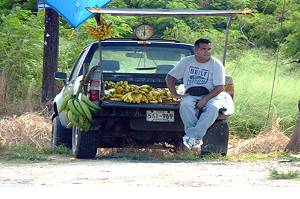
http://www.topuertorico.org/economy.shtml
Agriculture:
Until 1955, agriculture constituted Puerto Rico's main
economic sector. Sugar cane, mostly for export to the
American market, was the main crop, followed by coffee
and tobacco. Sugar cane production declined as prices
remained low, agricultural labor migrated to the United
States, and urban expansion took over much sugar cane
land. Coffee production, taking place mostly in the
mountainous areas away from the pressures of urban
expansion and supported by guaranteed minimum prices,
has remained stable. Tobacco production has virtually
disappeared. Considerable expansion has occurred in the
production of dairy products, beef, pork, eggs, and
poultry, although significant amounts of these products
are still imported, primarily from the United States.
There is also production of fruits and garden vegetables
as well as of starchy vegetables, such as bananas and
plantains.
Today, agriculture
accounts for only 3% of labor force and less than 1% of
GDP, concentrating primarily to crops which can be sold
in the United States. Coffee is the most valuable crop,
followed by vegetables, sugar cane, fruits (pineapples,
plantains, bananas), milk, eggs, and livestock (cattle,
chickens, pork).
Interesting Facts
·
Migration has played a large role in
social and economic changes since the 1950s. In the
1950s and 1960s, the government encouraged a massive
migration of poor agricultural workers to the east coast
of the US to help create a predominantly industrial
economy. The number of Puerto Ricans is now about equal
to the island's population.
·
Puerto Ricans are another immigrant group
that has had a significant impact on the economy and
culture of New York since World War II. Several hundred
thousand reside in the state, mostly in New York City.
After a heavy immigration of Puerto Ricans during the
1950s and early 60's, the growing economic strength of
Puerto Rico led to a considerable reduction, with those
entering the state being largely offset by those
returning to Puerto Rico.
·
Some of the best-educated young people
leave because of better opportunities and labor
conditions on the mainland.
·
Statistics show that it has some of the
most favorable economic conditions; the gross national
product (GNP) is growing much more rapidly than the
population, and the GNI per capita (formerly GNP per
capita) is one of the highest in the Caribbean, but in
comparison with the United States, Puerto Rico is still
below that of the poorest state in the mainland,
Mississippi. In 1989, Puerto Rico received 72 times more
food stamps than Mississippi, half the island's
population currently receives food stamps.
Books:
Puerto Rico: The Trials of the Oldest Colony in the
World
Other Resources:
The Decline of
the Plantation Economy and the Puerto Rican Migration of
the 1950s
by César J. Ayala (PDF)
Anthem:
Cabo
Rojo anthem:
By Mildred Arroyo
Hoy estoy triste por
la distancia
que me separa de mi
dulce patria,
y de un pueblito donde
mi
padre y mi madre me
esperan
Mi Cabo Rojo pueblo
adorado,
jardín de flores te
quiero yo
y en la distancia a ti
te añoro,
por eso lloro en mi
cantar.
Son tus palmeras
flores divinas
y son tus playas, un
manantial
Mi Cabo Rojo, me siento solo
por eso lloro en mi
cantar
pero muy pronto besaré tu suelo
o desde el cielo te adoraré.
Old pictures -
http://www.trincoll.edu/classes/hist378/archivo/prpics1.htm
Visiting Haciendas
Plantations (owners) in
Puerto Rico
http://www.pinterest.com/vilmacora/puerto-rico-the-past/
http://robertospuertorico.com/isla-southwest-region-puerto-rico/
Puerto Rico in the Great Depression
Agriculture
From Puerto Rico: A Guide to the Island of Boriquén
Federal Writers Project,
1940
-
http://newdeal.feri.org/pr/pr01.htm
-
The agriculture of Puerto Rico
is specialized and commercial, devoted primarily to
crops which can be sold in the United States. It is
subject to all the hazards of an external market in
which other tropical countries compete, and its
shippers are never certain about the stability of
their tariff protection, which corresponds to that
given similar industries on the mainland. But there
is no alternative to specialization within the
existing tariff walls and the system of market
distribution based on quotas.
-
If all the arable land on the
Island were planted to food crops for domestic
consumption rather than cash crops for export, it
would not begin to support the total population.
-
Such crops as sugar cane,
tobacco, and citrus fruits have proved the most
remunerative. Besides paying excellent dividends to
producers, especially in the case of sugar cane,
they have employed a large part of the population.
It is estimated that sugar cane alone has an annual
pay roll equivalent to 55 or 60 per cent of the
gross income of the crop. This figure in a normal
year under quota restriction may amount to
approximately $30,000,000. Considering the density
of population and the high prices of farms,
there is no choice but to devote the best lands to
the highest yielding crops. The problem lies in the
redistribution of land and the reduction of absentee
ownership, which exports profits with products.
-
Puerto Rico has depended on
agriculture since the primitive tribal economy of
the Boriquén Indians. Although the gold-seeking
conquistadores were hardly concerned with the
development of agriculture, Ponce de León
appreciated the richness of the soil and had some
land cleared for farming near Caparra and at
the estuary of the Toa or La Plata River. On
the latter site the first agricultural experiment
station and grange in the New World developed,
where experiments were carried on with crops from
other lands and livestock were acclimated. This was
"La Granja de Los Reyes Católicos" (Their Catholic
Majesties' Grange).
-
In 1765 the King of
Spain commissioned Don Alejandro O'Reilly to visit
the colony and make a report of his impressions. In
his report to the Crown, O'Reilly recommended that
skilled artisans and farmers be sent to the Island;
a government-owned sugar mill be installed;
uncultivated lands belonging to neglected grants be
confiscated by the Crown and divided among the new
farmers; and that crops be brought to the mill of
the Crown for grinding. He also recommended that
provision be made for vocational education in
agriculture, and the opening of adequate markets for
crops. One of the chief obstacles to the development
of agriculture at that time was the lack of
laborers, as the only people allowed to settle
in Puerto Rico were Spaniards. In 1778,
however, agriculture was greatly stimulated as the
result of a Royal Decree issued by the King of
Spain, allowing foreign Catholic laborers to
emigrate to the Island, where lands were given them.
In 1815 a Royal Decree of Grace was issued
whereby all foreigners were admitted to Puerto
Rico. For the first time in their colonial
history the Islanders were allowed to trade with
other nations and to import farm implements and
machinery free of duty.
-
The establishment of two experimental farms,
one in Rio Piedras and the other in Mayagüez in
1886, inaugurated the scientific study of
agriculture in Puerto Rico and led to systematized
plant introduction. The opening of the United States
Experiment Station in Mayag˜ez in 1902 marked the
beginning of a new era in scientific agricultural
research. In 1905 a land-grant college of
agriculture was established. In 1910 the Sugar
Producers Association organized an experiment
station in Rio Piedras which in 1914 became
the Insular Experiment Station. The Insular
Department of Agriculture was established in 1917.
Through the United States Department of Agriculture,
plants of economic importance have been introduced
or improved. Sugar cane varieties have been
imported which are resistant to the highly
troublesome mosaic or yellow-stripe disease,
discovered here in 1915, and plant quarantine
measures have served to check the disease. Imported
varieties—immune, resistant, or tolerant to
mosaic—were propagated on government farms and
distributed free to farmers. It has been generally
recognized that this work saved the sugar industry
of the Island from ruin. In the three-year period
1918-20, for example, the damage was estimated at
twelve to fifteen million dollars. The new varieties
that replaced the diseased and susceptible canes
have also resulted in increased sugar yields.
-
Important food plants,
such as rice, mangos, avocados, maize, coffee, and
green cover crops have been introduced in to the
Island. The experiment stations have improved
livestock by introducing better breeds of cattle and
other domestic animals. Fertilizers are being used
for nearly all important crops. Soil studies are
carried on to increase the efficient use of land
through fertilization and conservation methods, and
a survey of all the soils of the Island has been
made.
-
(…)
-
(…)
-
(…)
-
(…)
-
(…)
-
The problem is further
aggravated by the loss of ownership among small
farmers and the growth of large holdings. Since 1910
the proportion of land worked by owners to the total
under cultivation has declined by about 10 per cent.
More than one-third of all the agricultural land is
worked by managers in the employ of absentee owners,
yet these managed farms represent only about 7 per
cent of the total number.
-
The cattle industry
began with the first animals landed in 1509.
Subsequently the Island received domestic animals
from Europe, some directly and some through Santo
Domingo. This industry has not been of great
importance in Puerto Rico's economy since the
American occupation.
-
The development of the livestock industry has been
handicapped by the use of pasture lands for sugar
plantations. In recent years, however, dairying has
progressed considerably. There are well-kept dairy
farms in districts near the cities and larger towns.
The grade of dairy herds has been improved by the
introduction of Guernsey, Holstein, Jersey, Ayrshire,
and Shorthorn strains, and work cattle have been
cross-bred with Zebu or Brahman types. In spite of
this, the local market cannot supply the demand, and
the Island must depend on the importation of dairy
products. The mountain regions, however, offer
possibilities for the development of industry, when
roads and hydroelectric power are made available for
the farmers.
-
(…)
-
(…)
-
(…)
-
(…)
-
(…)
-
Hurricanes
have frequently wrecked the Island's agriculture.
Those of 1899, 1928, and 1932 were
especially bad, and the 1928 hurricane is
remembered as the most serious calamity in this
century.
-
SUGAR.
During the Spanish regime coffee was the
principal export product, sugar and tobacco
occupying second and third places. With the change
of sovereignty, the production of sugar cane rapidly
increased, and by the beginning of the twentieth
century it was the Island's most important
commodity. Since that time the growing of sugar cane
has continued to increase. As early as 1553,
Puerto Rico was exporting some 24,000 pounds of
sugar to Spain. Towards the close of the
sixteenth century sugar production in Puerto Rico
amounted to nearly 400,000 pounds, but this
precocious development suffered a setback during the
last years of the sixteenth century and early
seventeenth.
-
In the
nineteenth century, the production of sugar
showed a gradual and steady rise from 9,391 tons to
52,089 tons in 1899. The production in 1879
was nearly twice that of any year between 1872 and
1878. Production mounted higher in 1880 and 1884. At
the time of the American occupation sugar production
amounted to approximately 60,285 tons. In 1899 a
hurricane caused serious damage to the crop. The
beginning of the twentieth century marked a rise in
sugar production that has continued, with slight
intervals of decrease, until today. From 81,526 tons
in 1900, production rose to 992,335 tons in 1932,
and 1,103,822 tons in 1934. In 1938-9 sugar
shipments valued at $53,604,381 were exported to the
United States. This sum constituted about two-thirds
of the Island's total export to the United States.
-
TOBACCO.
The rise of the tobacco industry has fluctuated.
Since the time of the Spanish sovereignty, Puerto
Rican tobacco has enjoyed a reputation for good
quality, a fact which allowed it to sell in
competition with the best grades of Cuban tobacco.
The American sovereignty opened new and better
markets to the industry. Several American companies
opened cigar and cigarette factories in Puerto Rico
and purchased some of the best lands in order to
grow their own leaf. They also purchased the bulk of
the Island crop. Tobacco in Puerto Rico is grown
mainly in the mountainous region of the
interior, east from Utuado to San Lorenzo. Most of
it is of the cigarfiller type, but until 1926 much
was used as a wrapper. Chewing tobacco is grown in
the northern and southern regions. Exports of leaf
tobacco, mainly to the United States, increased from
$1,232,058 in 1907 to a little less than $3,000,000
in 1914 and nearly $14,000,000 in 1921. Between 1922
and 1926, exports fluctuated between $9,000,000 and
$14,000,000. In 1927 Puerto Rico exported tobacco
valued at nearly $21,000,000. In 1939-40 exported
tobacco was valued at $7,464,394. In exports,
tobacco occupies third place among Puerto Rican
products.
-
COFFEE.
During the Spanish regime, the Island's coffee was
popular in the Spanish, French, Italian, and other
European markets, which took about 50,000,000 pounds
of it annually. Production reached a maximum in
1915. The plantations were almost destroyed by
the hurricane of September 1928, and as a
consequence, European buyers were forced to look
elsewhere for their supplies. Trade barriers erected
against Puerto Rican products by various European
countries also considerably reduced exportation. The
greatest coffee exports of this century were those
of 1913 and were valued at $8,511,316. In 1939-40
the export of coffee amounted to 3,258,639 pounds
valued at $475,316.
-
Efforts
are being made by the Insular Department of
Agriculture to find a market for the coffee surplus.
Production in 1939-40 was 23,498,000 pounds.
-
FRUITS.
Shortly after the War with Spain a few Americans,
some of them ex-soldiers who came with the army in
1898, began the cultivation of citrus fruits.
Oranges, grapefruit, and limes were growing wild,
and a few felt confident enough in the future of
citrus to make small commercial plantings,
principally grapefruit. The fruit enjoys a good
reputation in both the American and European
markets, especially in England where it generally
brings a better price than the fruit from other
countries.
-
Fruit
exports to the United States showed a steady
increase from 1901, when they were valued at
$109,801, up to 1930. The figure rose to $1,000,000
in 1908, to more than $2,000,000 in 1911 and more
than $3,000,000 in 1930. The tropical storm of
September 1928 completely destroyed the crop,
causing heavy damage to trees, buildings,
machinery, and supplies, and inflicting a total loss
of $2,214,000 on the citrus industry. Again in
1932 more than 92 per cent of the
fruit industry was destroyed by another storm.
The industry in Puerto Rico has also suffered from
competition with other regions. In 1939-40,
$1,352,604 worth of fresh, canned, or preserved
fruits were exported.
-
Limes
have been exported in small quantities in the past;
an increasing demand for them is expected. In the
last few years pineapples have been widely planted
on a commercial scale. Bananas and plantains furnish
important staple products for the population, and
are not, exported. Other fruit crops are avocado,
mango, soursop, breadfruit, pomegranate, cashew, and
níspero (sapota).
-
MISCELLANEOUS. With the exception of head lettuce,
all the important vegetables of the temperate zone
grow satisfactorily On the Island, and moderate
quantities of tomatoes, peppers, cucumbers, squash,
eggplant, okra, and string beans are shipped to the
northern markets. High quality potatoes are grown
from tubers imported from the United States, and all
are consumed in the local market. Onions of the
Bermuda type grow successfully in the coastal lands,
especially on the northwestern section of the Island
but, since the culture is intensive and wholly by
hand, the cost of production does not permit
exportation.
-
The
diet that prevails even today among many Puerto
Ricans in rural areas—polished rice, beans, and
codfish—is expensive and inadequate from the health
standpoint. The Department of Education has for many
years striven to encourage the planting of garden
vegetables. (…)
-
Root
crops such as sweet potatoes, cassava, yams, dasheen
and taro, are staples for the Puerto Rican peasant.
Were it not for these foodstuffs his diet would be
even more deficient. Other crops grown wholly for
home consumption are corn, beans, pigeon peas,
cowpeas, peanuts, and sesame. Corn, beans, and
pigeon peas are grown on a large scale in regions
where crop diversification is practiced.
-
Ginger,
of Asiatic origin, became an important crop in the
seventeenth century, taking first place among export
products in the year 1644, but today it is grown
only in small quantities in the interior where the
climate is especially suitable.
-
The
coconut industry, severely damaged by
hurricanes, shows alternative periods of
prosperity and depression. Export values of this
crop rose from $8,334 in 1901 to $129,793 in 1906
and steadily up to $1,888,321 in 1927, dropping to
$523,070 in 1929 as a result of the hurricane. In
1939-40 exports of coconuts were valued at $308,620.
-
Rice,
an important crop at a time when land and labor were
cheap, is now grown only in the higher altitudes.
The total production is scanty compared with the
large quantities imported every month from the
United States. It is a main item on native tables.
-
Cacao,
from which cocoa is obtained, was important in the
early days of the Island. Plantations growing cacao
suffered severely from the hurricanes, and
this factor, to-together with the competition of
other countries, has practically eliminated its
production.
-
Cotton
of the long-staple, sea island type is grown in
small areas in the southern and northwestern parts
of Puerto Rico, along the coastal region. Until 1932
nearly 10,000 acres were planted to cotton. Then a
sudden loss of the market in the United States
reduced the acreage to almost nothing. A new
beginning was made in the crop season of 1934-35,
and in 1939-40, 250,174 pounds of cotton lint,
valued at $74,595, were exported.
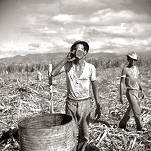
1938 |

1940 |
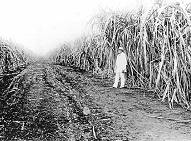
A sugar baron inspects his cane. |
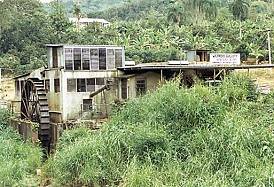 |
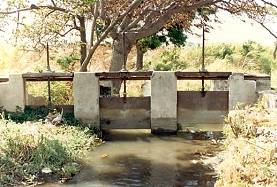 |
|
Mills were
built. The old irrigation systems are still on
the ground, but the water runs to the sea,
unused. |
Here, the stacks of a
ruined sugar mill near Guanica, where American troops
landed during the Spanish-American War. Puerto Rican rum
is made nowadays with imported sugar. Bits of cane
continue to be harvested.http://www.globalresearch.ca/us-hegemony-and-puerto-ricos-economic-crisis/5361819
Another key
undertaking: a twisting, narrow, but well-built mountain
road, still typical of the roads in the island's
interior.
For a long time, the
island's economy rested on sugarcane. That industry has gone
into terminal decline, but there are plenty of relics, like
this veranda-wrapped farm building. Out
in the countryside, sugarcane plantations required
irrigation ditches, although the collapse of the industry
has left the water running to waste.
They're transported with
equipment that one would think had disappeared from the
United States.
A corrective
picture: some operators do use modern equipment
http://www.sockowashere.com/states.php?state=61
Sugar Cane - The Spanish brought sugar
cane to Puerto Rico from the Dominican Republic in the
mid-1500s. Sugar mills popped up around the island
processing the sugar cane into brown sugar, molasses,
and table sugar. Sugar cane is also the main ingredient
in rum, another Puerto Rican export. The industry peaked
in the 1950s, with over 40 sugar mills and refineries
processing nearly 1 million tons of sugar. Today there
are only a couple of working sugar mills left, but you
can still see the rusting remnants of a once proud
industry peppering the island.
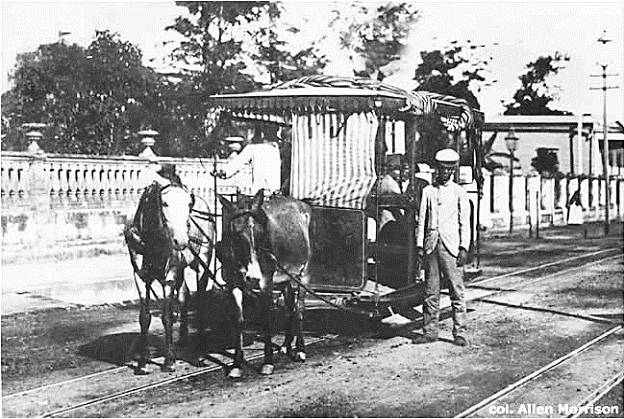
In addition to the street
railways and the American Railroad line, the Central
Rochelaise 4 km south of Mayagüez operated 4.3 miles (7
km) of railway around its sugar plantation. Its lines
http://www.tramz.com/pr/my.html
Spanish expeditions in Puerto Rico

Conquering the island
1508-1514
Spanish-Cuban-American
war. Invasion of Puerto Rico.
http://www.latinamericanstudies.org/spanwar9.htm
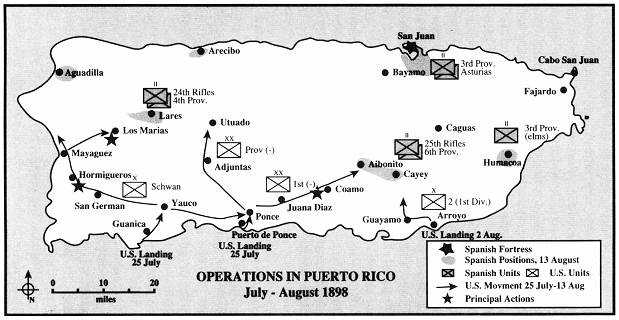
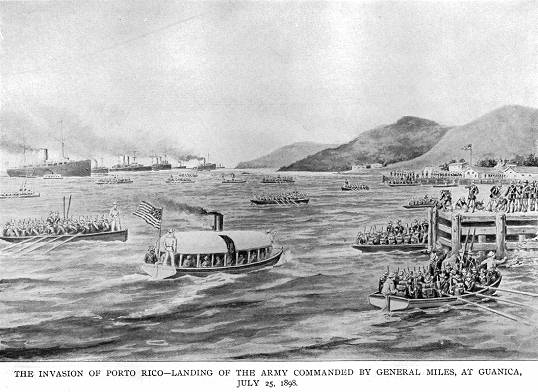
Landing at Guanica, July
25, 1898
Crop distribution in Puerto Rico,
1900 - 1935
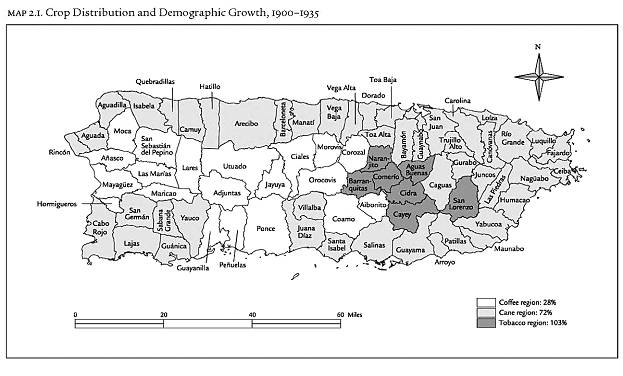
|